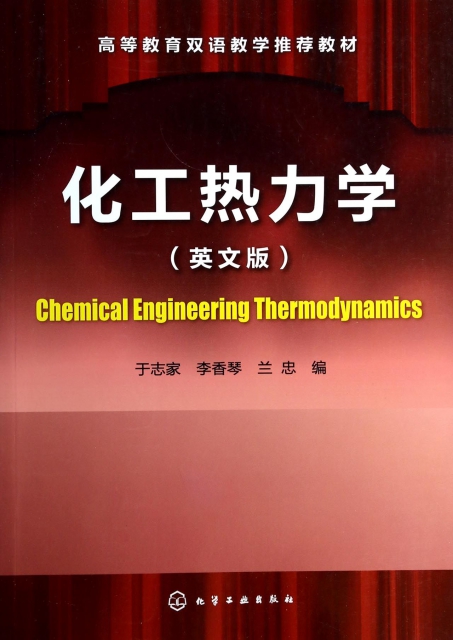| | | | 化工熱力學(英文版高等教育雙語教學推薦教材) | | 該商品所屬分類:工業技術 -> 能源與動力工程 | | 【市場價】 | 446-648元 | | 【優惠價】 | 279-405元 | | 【介質】 | book | | 【ISBN】 | 9787122188700 | | 【折扣說明】 | 一次購物滿999元台幣免運費+贈品
一次購物滿2000元台幣95折+免運費+贈品
一次購物滿3000元台幣92折+免運費+贈品
一次購物滿4000元台幣88折+免運費+贈品
| | 【本期贈品】 | ①優質無紡布環保袋,做工棒!②品牌簽字筆 ③品牌手帕紙巾
|
|
| 版本 | 正版全新電子版PDF檔 | | 您已选择: | 正版全新 | 溫馨提示:如果有多種選項,請先選擇再點擊加入購物車。*. 電子圖書價格是0.69折,例如了得網價格是100元,電子書pdf的價格則是69元。
*. 購買電子書不支持貨到付款,購買時選擇atm或者超商、PayPal付款。付款後1-24小時內通過郵件傳輸給您。
*. 如果收到的電子書不滿意,可以聯絡我們退款。謝謝。 | | | |
| | 內容介紹 | |

-
出版社:化學工業
-
ISBN:9787122188700
-
作者:於志家//李香琴//蘭忠
-
頁數:298
-
出版日期:2014-05-01
-
印刷日期:2014-05-01
-
包裝:平裝
-
開本:16開
-
版次:1
-
印次:1
-
字數:488千字
-
於志家、李香琴、蘭忠編著的《化工熱力學》共分九章。內容基於讀者已學完物理化學課程的熱力學基礎進行組織,編排次序注重課程內容*好的銜接。第一章是緒論,介紹熱力學的發展及熱力學**、第二定律;第二章闡述流體的p-V-T關繫;第三章介紹純組分熱力學性質的計算;第四章是混合物熱力學性質的計算;第五章為溶液熱力學基礎;第六章是流體相平衡,重點闡述了汽液平衡計算,對氣液與液液平衡亦作了適當的介紹;第七章為流動過程熱力學,介紹典型化工過程的流體輸運、功能熱轉換與計算;第八章闡述流體的動力循環與制冷循環;第九章為化工過程的節能分析。前五章重點闡述化工熱力學的基礎理論,後四章著重體現了化工熱力學理論與化工生產實踐的結合。
-
於志家、李香琴、蘭忠編著的《化工熱力學》應
國內高校化工熱力學課程雙語教學的需要,吸取國內
外最新教材的精華,參考國內多數高校執行的48學時
安排與雙語教學的需要與特點,精選教學內容,采用
英文編寫。
《化工熱力學》講述並應用熱力學基本原理,闡
述流體的熱力學性質及相平衡,對化工過程進行節能
分析。原理闡述簡練,例題與習題適量,注重利用熱
力學原理解決實際化工生產問題。
《化工熱力學》共分九章,主要內容有:導論,
流體的p-V-T關繫,流體的熱力學性質,混合物的熱
力學性質,溶液的熱力學性質,流體相平衡,流動、
壓縮及膨脹過程熱力學計算,蒸汽動力循環及制冷循
環,化工過程的熱力學分析。書中各章都配有例題及
一定量的習題。習題設置注意知識點覆蓋,並附有答
案。
《化工熱力學》可作為高等學校化工類專業本科
生的雙語教學教科書與教學參考書。
-
Chapter 1 Introduction
1.1 The Scope of Chemical Engineering Thermodynamics
1.2 System and Surroundings
1.3 The Chemical State and Fluid Properties
1.4 The First Law of Thermodynamics
1.4.1 The first law of thermodynamics for controlled mass system
1.4.2 The first law of thermodynamics for controlled volume system
1.5 The Second Law of Thermodynamics
1.5.1 The upper limit for the conversion of heat into work
1.5.2 Entropy
1.5.3 Mathematical statement of the second law
Problems
Chapter 2 Volumetric Properties of Fluids
2.1 p-V-T Behavior of Pure Substances
2.2 The Equations of State(EOS)of Fluid
2.2.1 The EOS of ideal gas
2.2.2 Virial equations of state
2.3 Cubic Equations of State
2.3.1 The van der Waals equation of state
2.3.2 The Redlich-Kwong(R-K)equation of state
2.3.3 The Soave-Redlich-Kwong(SRK)equation of state
2.3.4 The Peng-Robinson(P-R)equation of state
2.3.5 A generic cubic equation of state
2.4 Generalized Correlations of Gases
2.4.1 Theorem of corresponding states
2.4.2 Generalized cubic EOS
2.4.3 Two-parameter theorem of corresponding states
2.4.4 Three-parameter theorem of corresponding states
2.4.5 Generalized correlations of the second virial coefficient
2.5 Liquid & Liquid-like Roots of the Generic Cubic EOS
2.6 Generalized Correlations for Liquids
Problems
Chapter 3 Thermodynamic Properties of Fluids
3.1 Property Relations for Homogenous Phases
3.2 Calculations of Enthalpy and Entropy
3.3 Residual Properties
3.4 Residual Properties by EOS
3.5 Calculations of Liquid Enthalpy and Entropy
3.6 Generalized Property Correlations for Gases
3.6.1 Generalized compressibility factor Z for residual enthalpy and residual entropy
3.6.2 Generalized second virial coefficient for residual enthalpy and residual entropy
3.7 Thermodynamic Diagrams
3.8 Tables of Thermodynamic Properties
3.9 T-S Diagrams
3.9.1 Heating and cooling processes at isopiestic pressure
3.9.2 Throttling expansion processes
3.9.3 Isentropic expansion or compression processes
3.10 p-H Diagrams
3.11 H-S Diagrams
Problems
Chapter 4Thermodynamic Properties of Mixtures
4.1 The Mixing Rules
4.2 The Calculations of Vm,mix and Zmix
4.2.1 Amagat’s law(part volume law)combined with Z graphs
4.2.2 EOS for a mixture of real gases
4.3 The Calculations of HR and SR
4.3.1 The calculations of HR and SR by EOS
4.3.2 The calculations of HR and SR by generalized correlation graphs
Problems
Chapter 5 Solution Thermodynamics
5.1 Property Relations for Open Systems and Chemical Potential
5.2 Partial Properties
5.3 Fugacity and Fugacity Coefficient
5.3.1 Fugacity calculations for pure gases
5.3.2 Fugacity calculations for pure liquids
5.3.3 Fugacity calculations for species in solution
5.3.4 Application of Microsoft Excel in the thermodynamic property calculations
5.4 The Ideal Solution and Standard State
5.5 Excess Properties and Property Change in Mixing
5.5.1 Excess properties
5.5.2 Property change in mixing
5.5.3 H-x graph
5.6 Activity and Activity Coefficient
5.6.1 The Wohl type equations
5.6.2 The gamma equation based on local composition
5.6.3 The UNIQUAC and UNIFAC model
Problems
Chapter 6 Phase Equilibrium
6.1 The Criterion of Phases Equilibrium
6.2 Vapor-Liquid Equilibrium
6.2.1 VLE under low pressures
6.2.2 VLE under moderate pressures
6.2.3 VLE under high pressures
6.3 Gas-Liquid Equilibrium
6.4 Liquid-Liquid Equilibrium
6.4.1 LLE phase diagrams
6.4.2 The stability of liquid solution
6.4.3 LLE calculations
6.5 Vapor-Liquid-Liquid Equilibrium (VLLE)
Problems
Chapter 7 Thermodynamics of Flow Process
7.1 Conservation of Mass
7.2 Conservation of Energy
7.3 Entropy Balance
7.3.1 Concept of entropy
7.3.2 Entropy balance
7.4 Processes Analyzed by Thermodynamics Methods
7.4.1 Fluid flowing
7.4.2 Compression process
7.4.3 Expansion process
7.4.4 Throttling process
Problems
Chapter 8Thermodynamics Cycle
8.1 Carnot-Cycle and Its Anticlockwise Cycle
8.2 Rankine-Cycle & Steam Power Plant
8.2.1 Improving of the Carnot engine
8.2.2 Improving of the Rankine engine
8.3 Vapor Compression Refrigeration Cycle
8.4 Absorption Refrigeration
8.5 Heat Pump
8.5.1 A brief historical development of heat pumps
8.5.2 Vapor compression HP
8.5.3 Absorption heat pump
Problems
Chapter 9 Thermodynamic Analysis of Processes
9.1 Ideal Work
9.1.1 Non-flowing process
9.1.2 Steady-state flow process
9.2 Lost Work
9.3 Typical Problems
9.3.1 Tube flow
9.3.2 Heat transfer
9.4 Energy Optimization
Problems
Appendix
Appendix A Conversion Factors and Values of the Gas Constant
Appendix B Properties of Pure Species
Appendix C Heat Capacities and Property Changes of Formation
Appendix D The Lee/Kesler Generalized Correlation Tables
Appendix E Steam Tables
List of Symbols
Selected Glossary in Chemical Engineering Thermodynamics with Chinese Translation
References
| | |
| | | | |
|




